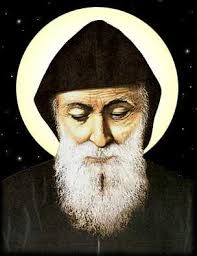 St. Sharbel was born Yousef Antoun Makhlouf in 1828 in the mountains of Northern Lebanon. He was raised into a devout Christian family, and was one of five children. He wanted to become a monk from a young age. He helped his family tend to a small flock of sheep and goats, and often took the flock to a grotto to pray before the Blessed Virgin Mary. This grotto became “his first hermitage and altar of worship.” When he became a monk of the Lebanese (Catholic) Maronite Order at 23, he took the name “Sharbel.” He completely devoted his life to Christ “with an undivided heart.” St. Sharbel died on Christmas Eve in 1898 before the presence of the Eucharist. When one of the monks visited the tabernacle at midnight following his death, he saw a light surrounding the tabernacle and St. Sharbel’s body. Many people, including Christians and Muslims, reported light illuminating from St. Sharbel’s tomb after his death. He is most well-known for his powerful intercession for the sick; many miracles have occurred through his intercession.
St. Sharbel was born Yousef Antoun Makhlouf in 1828 in the mountains of Northern Lebanon. He was raised into a devout Christian family, and was one of five children. He wanted to become a monk from a young age. He helped his family tend to a small flock of sheep and goats, and often took the flock to a grotto to pray before the Blessed Virgin Mary. This grotto became “his first hermitage and altar of worship.” When he became a monk of the Lebanese (Catholic) Maronite Order at 23, he took the name “Sharbel.” He completely devoted his life to Christ “with an undivided heart.” St. Sharbel died on Christmas Eve in 1898 before the presence of the Eucharist. When one of the monks visited the tabernacle at midnight following his death, he saw a light surrounding the tabernacle and St. Sharbel’s body. Many people, including Christians and Muslims, reported light illuminating from St. Sharbel’s tomb after his death. He is most well-known for his powerful intercession for the sick; many miracles have occurred through his intercession.
Pope John Paul II often said that the Church has “two lungs—East and West—and it must learn to breathe using both of them.” Remembering saints like Sharbel helps the Church to appreciate both the diversity and unity present in the Catholic Church. Like all the saints, Sharbel points us to God and invites us to cooperate generously with God’s grace, no matter what our situation in life may be. As our prayer life becomes deeper and more honest, we become more ready to make that generous response.
From the website of St. Sharbel Parish in Portland: “Maronite spirituality, liturgy and traditions come from Antioch-Edessa, Syria as they were known in the Roman Empire at the time of Christ. The Aramaic language, used in our liturgy, is the same language Jesus spoke during his earthly life and ministry. The Maronite Church, one of the oldest churches of Catholicism, was led by Saint Maron, a priest (350-410 AD) who devotedly taught the Catholic faith, and ministered to many people with his gifts of healing and counsel. Today in the U.S. there are about 75,000 Maronite Catholics. We are in union with Rome and are part of the one true Catholic Church.” For more: http://stsharbel.org/
Did You Know …? The Catholic Church is actually composed of 24 churches — one Latin (Roman), which comprises perhaps 98% of all Catholics worldwide, and 23 “Eastern” or “Oriental” churches (among them, the Maronite Church). All recognize the authority of the papacy, but within the parameters of a shared Creed, each has its own forms of liturgy, devotions, and traditions. Each has its own hierarchy under a patriarch or archbishop, and distinctive Eastern legal canons. Liturgy is a defining aspect of these churches’ identity. All of these churches embody traditions and practices that are at least a millennium old, and are heirs to the original Christian tradition of a particular region. Many trace their origins back to the Apostles or to Apostolic times. For more on the Eastern Churches within the Catholic Church: https://www.catholicsandcultures.org/eastern-catholic-churches

